Biceps muscle stretching
Table of Contents
Introduction
Biceps stretching exercise is an important exercise to increase the flexibility of the upper arm muscles mainly the biceps. The described exercise is easy to perform the home exercises and the patient can do it after a biceps workout or before starting the exercise as a warm-up of the arm muscles.
Regular exercise also assists to increase the functionality of the arm as well as decreasing the chances of injury to the biceps muscles.
Biceps tightness is most commonly seen in individuals who are doing regular biceps workouts. If the patient adds this stretching exercise after the biceps workout assists the patient in reliving the biceps tightness.
This article will be informed the patient about various types of biceps stretching exercises, health benefits as well as a common mistakes the patient should avoid while stretching exercises.
What is the function of the biceps muscle?
- The biceps muscle is situated d in the front part of an upper arm. This has two tendons, one is short as well as the other is a long tendon that combines to make the biceps tendon. This works together as the flexor of an elbow & supinator of a forearm. It is the main muscle of elbow flexion. Bicep stretches are the perfect way to complement the upper-body workout.
- Bicep stretches are a low-impact body movement that can assist the patient with lots of activities, from carrying groceries into a home in one trip to performing a few repetitions in the workout.
Health Benefits of the biceps muscle stretching
There are ample benefits of biceps stretching, some are below :
- Increase flexibility
- Improves range of motion
- Increase muscle function
- Reduced muscle tightness or tension
- Increase posture
- Relaxation as well as well-being
- Lower the risk of an injury
- Improve strength
- Increase athletic performance
How To Stretch Biceps
- A bicep brachii muscle consists of a short head as well as a long head that originates at the upper part of the shoulder blade & insert on the top of the forearm. As well as a brachialis muscle which is located on an outer part of the upper arm. Deep fascia of the forearm (insertion of the bicipital aponeurosis)
- When they contract, the biceps create arm flexion that moves the forearm up toward the shoulder. Another function of a bicep is to rotate the palm up, also called supination.
- So stretching the biceps requires the opposite movement to lengthen the muscles. In other words, bicep stretches involve extending the arm as well as rotating the wrists.
Various types of the biceps stretching exercise
- Shoulder extension with the cane
- Biceps stretch sitting on the chair
- Bilateral biceps stretch
- Biceps stretch with the tubing
- Biceps stretch in the lying position
- Assisted biceps stretch in lying position
- Standing biceps stretching exercise
- Seated biceps stretching exercise
- Doorway biceps stretching exercise
- Wall bicep stretching exercise
- Horizontal arm extensions exercise
- Horizontal hand rotations exercise
- Hang from the pull-up bar.
- Half-kneeling biceps stretch.
Shoulder Extension with the cane
- How to perform: First of all, the patient should take a standing position. After that, use the cane to do the shoulder extension stretching. one end of a cane holds my left hand as well as the other end of the right hand, so the left biceps feels the stretch.
- Now keep the left elbow straight & use the right arm to push the left arm backward with the cane. Next, hold an end position for 10-15 seconds & back to the embarking position. Repeat the motion 5-6 times. Now do this on a right hand as well.
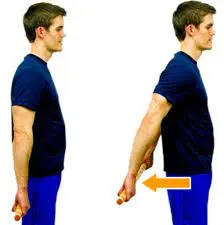
Biceps stretch sitting on a chair
How to perform: To begin with, the therapist tells the patient to take the sitting position on the chair. Place the palms on the chair in a flat position as well as the fingers are signaling backward. After that, slowly bend backward until the patient feels a gentle stretch in the front side of the arm. Next, hold the ending position where the patient felt stretched for 10 seconds. Repeat the stretching 8 -10 times.
Bilateral biceps stretch
- How to do: To embark, the physical therapist should tell the patient to take a standing position. After that, place the arms straight as well as the fingers interlaced. Now, embark on raising the arms upwards in front of the patient until they reach the overhead position. Then, hold this position where the patient feels stretched for 10 seconds. Repeat this movement 8-10 times.
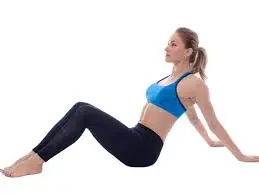
Biceps stretch with tubing
- How to do: To start with, the patient should take the standing position with arms forward as well as straight, so palms facing downward.
- Next, hold both ends of tubes in the hands as well as sweep them up. After that, take the overhead position with tubing then behind the back as well as the elbow is straight. Hold the stretch for 10 seconds & repeat 8-10 times.
Biceps stretch in lying position
- How to do: To start with, take a supine position. Put the folded towel under the arm, slightly above an elbow. The arms are slightly away from the body as well as palms are facing upward. Now relax & lose the hands to fall with a gravity pull.
- The patient can feel a stretch in front of the arm. Hold the stretch for 10 seconds & repeat 8-10 times.
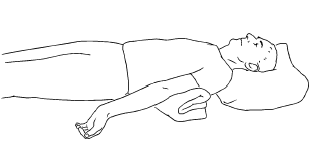
Assisted biceps stretch lying
- How to do: First of all, the physical therapist tells the patient to take a prone position with both hands behind the back with fingers interlaced. Now the patient needs one partner to raise the hands upward until the patient feels stretched in front of the arm.
- Hold it for 10 seconds as well as repeat it 8-10 times in one session. Do three sessions per day.
Standing biceps stretching exercise
- To do the stretching: Stand straight & interlace the hands behind the back at the base of the spine. Now slowly straighten the arms as well as turn the palms downward. Then, instruct the patient to raise the arms upward as much as the patient can.
- When the patient felt stretched, stop & hold it for 1 minute. Repeat 1 -3 times in one session. Do three sessions per day.

Seated biceps stretching
- To do the stretching: The patient should take a long sitting position on the ground. Then bend the knees, so the feet are flat on the ground in front of the hips. Now place the hands on the floor behind the back with fingers pointing away from the body. Equally distribute the body weight between the arms, feet, as well as buttocks. Slowly move the buttocks forward without moving the palms.
- If you feel stretched in front of your arms then hold the position for 30 seconds. Return to the starting position & take a rest for a few seconds. Repeat it 2-4 times.
Doorway biceps stretching
- To do the stretching: Stand in the doorway with the right hand holding a doorway at the waist level. After that, take a step forward with the right foot & bend the knee, then transfer the weight forward.
- The patient can feel the stretch in the right arm & shoulder while keeping the elbow slightly bending position. Hold it for 30 seconds & repeat on the left side.

Wall bicep stretching
- To do the stretching: Press the right palm against the wall or even a steady object. After that, slowly rotate the body away from the wall.
- The patient feels the stretch in the right arm, chest, as well as the shoulder. Hold it for 30 seconds & repeat it on the left side.
Horizontal arm adduction
- The patient can perform the stretching exercise in the standing or even sitting position. The stretch combines active movement with stretching.
- To do the stretching: Extend or even abduct the arms out to the side, so they are parallel to the floor. Now turn the thumbs downward so the palms are facing behind the patient’s body.
- Hold this position for 30 seconds. Now pulse the hands backward as well as forward for 30 seconds.
- Do the described exercise for 2-3 sets & gradually increase holding time.
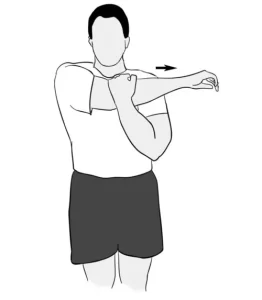
Horizontal hand rotations
- The stretching gently stretches the biceps muscle.
- To do the stretching: Stand straight with the arms abducted forward up to 90 degrees, palms facing the ground. After that, do the forward rotation of the shoulders by turning the thumbs downward.
- Then, return to the embarking position. Again rotate the shoulders, but this is the backward rotation by turning the thumbs upward.
- Come back to the embarking position. Do 2-3 sets for one minute.
Hang from a pull-up bar
- The hanging bar stretch targets pretty much the whole upper body. Grab the pull-up bar firmly with the palms facing away from the face of the patient, about shoulder-width apart. Hang with the arms straight for up to 1 minute. Repeat this exercise up to 3 times in one session to really stretch the muscles out.
- If the patient cannot reach a pull-up bar, stand on the step, a chair, or even the bench to grab it.
- The patient can do this with any kind of bar if the patient does not have a pull-up bar available, like the monkey bars at the playground.
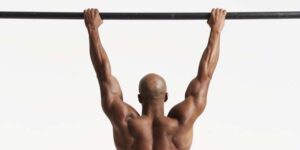
Half-kneeling biceps stretch
- This utilizes the table or another flat surface to stretch the biceps. Stand facing away from the flat, elevated surface, like the table or even desk. Place the backs of the hands behind the patient’s body on a surface, so the palms are open as well as facing up. Get into the half-kneeling position, or the lunge position, & hold the stretch for 30 seconds.
- To get into the half-kneeling lunge position, place one foot in front of you & bend down so the thigh of the front leg is straight out in front of you & the knee of the back leg is touching the floor. As an alternative to a half-kneeling position, instruct the patient to squat down until the patient feels a stretch in the biceps.
Avoid some common mistakes for effective as well as safe stretching
- Arching/Rounding a Back: Arching or rounding the back indicates bad posture while the movement. Focus on proper body
- mechanics as well as spinal awareness to perfectly stretches the biceps.
- Overstretching: Overstretching may increase the chances of muscle injury. Do the motion by stretching to a point of tension, not pain. It will increase the stretching benefit, lower the chance of potential injury, as well as promote a good experience.
- Bouncing while the Movement: A bicep stretch is not bouncing but it is a controlled movement that includes the static stretch. This is suggested to avoid ballistic stretching due to the muscles/tissues are more prone to injury.
- Assure that the patient is performing the right exercise: Assure the physical therapist before beginning a stretching exercise, if the patient is doing right or wrong to avoid another muscle injury.
- Issues With Over-Extension: If the patient is feeling any discomfort or even pain while a stretching exercise, then stops right there due to he/she may do it incorrectly and causes injury.
- Equipment Safety: When using the elasticated resistant band use precaution, to assure it does not snap back to you as well as hit you in the face. While performing biceps stretching there is no need to have some instrument or equipment in most of the stretching exercises.
FAQ
How do you stretch the sore bicep?
With palms down, raise an arm on the injured side, as well as touch the thumb side of the hand to a wall. Keep the arm straight as well as turn the body away from the raised arm until the experience a stretching sensation in the bicep. Hold the stretch for 15 seconds, rest, & then complete 2 more repetitions
What causes tight biceps?
Bicep tendonitis is the inflammation of the tendons that connect a biceps muscle, at the front of the arm, to the shoulder and the elbow. A repetitive movement injury, bicep tendonitis often results from overuse caused by repeated overhead motion.
Why do biceps hurt?
Common causes of pain in the middle of the bicep include muscle strain, bruises, as well as DOMS after exercise. Mild injuries usually get better on their own, while more severe ones can require medical treatment and physical therapy. Sometimes, pain in the left arm can indicate a heart attack.
What does a bicep tear feel like?
The most common symptom of the bicep tear or strain is the sudden burst of pain in the upper arm near the shoulder. The patient could also hear a “popping” sound as the tendon tears. Other signs that you can have torn a bicep tendon can include Weakness in the shoulder.
Will torn biceps heal themselves?
Once the bicep is torn, it, unfortunately, will not reattach itself to a bone & heal on its own. There are, however, a variety of treatment options available depending on the severity of the injury & whether it was a partial or complete tear.

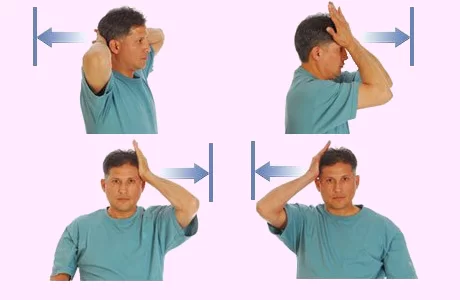

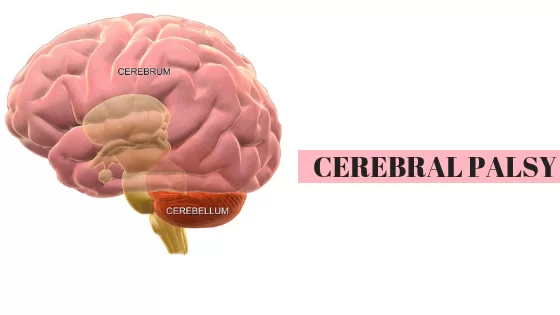
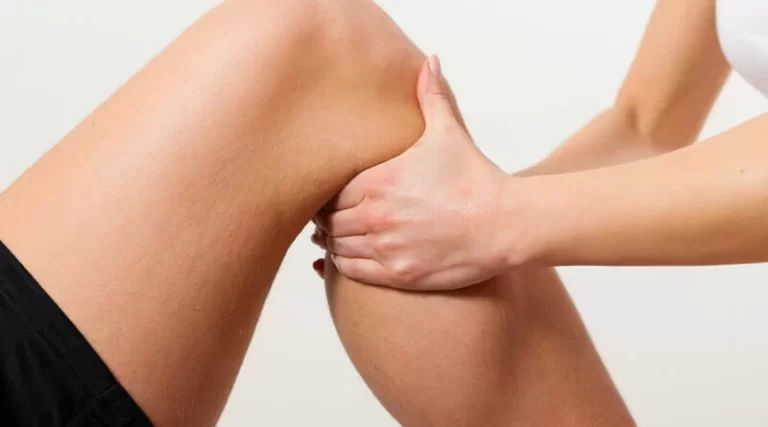
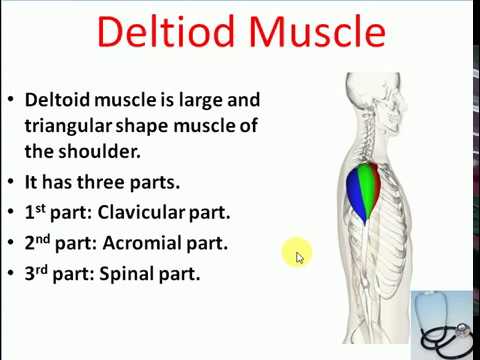

4 Comments